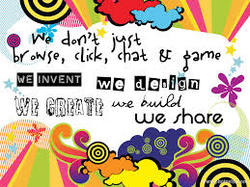
In the following four articles, teachers have a found a way to incorporate the popular app, Instagram, into the classroom. I love reading about innovative ways to grip students and encourage participation. I believe that using programs and apps like Instagram is transforming instruction and is a necessary way to engage students. Check out the articles below.
Kids Speak Out on Student Engagement
Every time I sit down to do a lesson plan I think about engaging my students. My biggest challenge is trying to find an activity that allows them to learn the content as well as challenge them. I think rigorous tasks motivate students to try. I try to stay away from meaningless, repetitive math exercises. After reading the article about with kids say engage them, I thought I could commit to the following three ways. One is creating projects that relate to the real world, because it is so easy to do this in math and it is the only way they will grow to love math. Secondly, I will show that I love what I do and be enthusiastic. I think staying positive and loving math will only transfer to the kids and motivate them to see what I’m so excited about! Lastly, I will use more visuals. Doing math problems can be so boring and adding a visual will entice the students and spice things up a bit.
#InstagramELE challenge!
This type of challenge turns students into active learners while participating in the lesson rather than just receiving knowledge. On a developmental level, being social is something high schoolers prioritize, so having activities that incorporate content into being social makes it more likely that students will be involved and interested in their own learning process. It lets kids be creative and choose how they want to learn (in this case spanish vocabulary) as well as see what others are doing. It is a way for kids to buy in to their education and to connect with the global community. I would love to do a project like this with my kids.
Instagram Scavenger Hunt
I can see myself using this type of activity with my students. One challenge I think I would come across is assuming that all my students have an instagram account or that have devices that allow them to participate. What do you do if two students don't have smart phones and can’t participate. It is a great enriching activity, but if everyone can’t participate, do we still require them to do it? Also, if a couple students have never used instagram, then there needs to be time set aside in class to review expectations for the assignment, like hashtags and tagging people. I think I would like to make modifications on what they captions say and make sure students are writing something productive and thinking critically about the project and it is actually contributing to their learning, instead of being a superfluous assignment just because it is involving technology.
3 Ways Colleges Use Instagram
I think the three ways why Instagram is useful in college, ask questions, feed other social networks, encourage participation, are applicable in the classroom too. Pictures are appealing to users, in a social media world, because it conveys messages through images instead of words. You can use instagram in your classroom to get students to ask questions about new units of study, to post to other social networks you have set up in your class like twitter, and to encourage students to participate in creative ways.
After reading these articles it seems like Instagram is a pretty useful tool for student engagement, easy to use and free! Now, the trick is staying abreast the rapidly changing technological world and keeping up with our students’ technology interests. What is next? How can we use snap chat in the classroom?
Kids Speak Out on Student Engagement
Every time I sit down to do a lesson plan I think about engaging my students. My biggest challenge is trying to find an activity that allows them to learn the content as well as challenge them. I think rigorous tasks motivate students to try. I try to stay away from meaningless, repetitive math exercises. After reading the article about with kids say engage them, I thought I could commit to the following three ways. One is creating projects that relate to the real world, because it is so easy to do this in math and it is the only way they will grow to love math. Secondly, I will show that I love what I do and be enthusiastic. I think staying positive and loving math will only transfer to the kids and motivate them to see what I’m so excited about! Lastly, I will use more visuals. Doing math problems can be so boring and adding a visual will entice the students and spice things up a bit.
#InstagramELE challenge!
This type of challenge turns students into active learners while participating in the lesson rather than just receiving knowledge. On a developmental level, being social is something high schoolers prioritize, so having activities that incorporate content into being social makes it more likely that students will be involved and interested in their own learning process. It lets kids be creative and choose how they want to learn (in this case spanish vocabulary) as well as see what others are doing. It is a way for kids to buy in to their education and to connect with the global community. I would love to do a project like this with my kids.
Instagram Scavenger Hunt
I can see myself using this type of activity with my students. One challenge I think I would come across is assuming that all my students have an instagram account or that have devices that allow them to participate. What do you do if two students don't have smart phones and can’t participate. It is a great enriching activity, but if everyone can’t participate, do we still require them to do it? Also, if a couple students have never used instagram, then there needs to be time set aside in class to review expectations for the assignment, like hashtags and tagging people. I think I would like to make modifications on what they captions say and make sure students are writing something productive and thinking critically about the project and it is actually contributing to their learning, instead of being a superfluous assignment just because it is involving technology.
3 Ways Colleges Use Instagram
I think the three ways why Instagram is useful in college, ask questions, feed other social networks, encourage participation, are applicable in the classroom too. Pictures are appealing to users, in a social media world, because it conveys messages through images instead of words. You can use instagram in your classroom to get students to ask questions about new units of study, to post to other social networks you have set up in your class like twitter, and to encourage students to participate in creative ways.
After reading these articles it seems like Instagram is a pretty useful tool for student engagement, easy to use and free! Now, the trick is staying abreast the rapidly changing technological world and keeping up with our students’ technology interests. What is next? How can we use snap chat in the classroom?

 RSS Feed
RSS Feed
